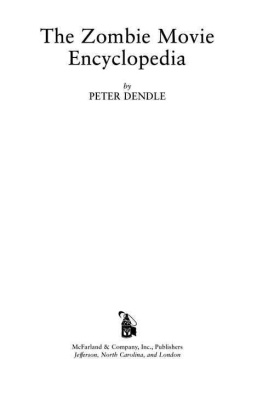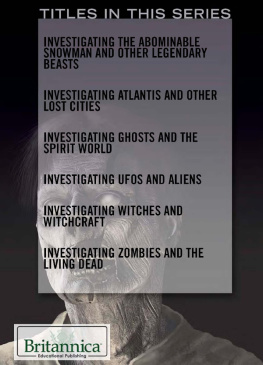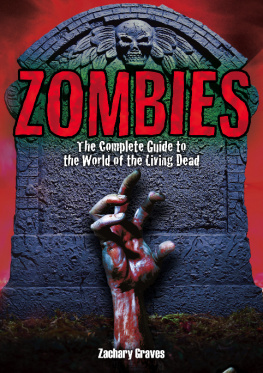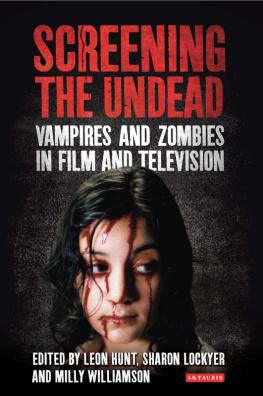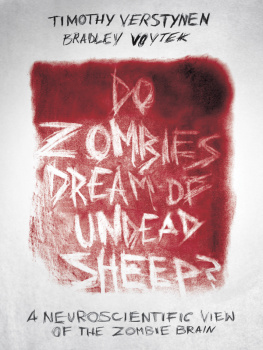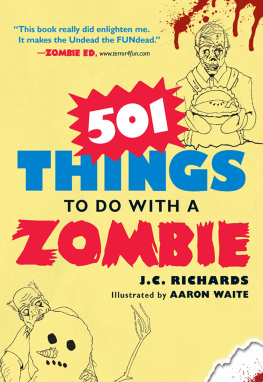
The Zombie Movie Encyclopedia
The Zombie Movie
Encyclopedia
by
PETER DENDLE






For "Bub"we're right behind you

Acknowledgments

The Lexington crew:
Amy Goff-Yates.
Michael Kim, Susan Adams, Tom Arnold, Diane Timmons, Jim Shaw, Vida Vitagliano, Amy Baxter, John Mayfield, Erik Siegel, Joe "Mr. Friendly" Conkwright, Buck Reynolds, Blake "Flipper" Cox, Mike Joyner, Joel Glenn, J.J. Haws, Becca Stormcrowe, Bill Baxter III, Scott Hand, Lisa Brandenburg, Shelby Thacker, Steve Heiner, Ernesto Delgado, Claudia Silvy, Lalana Powell, and The Kentucky Theater-a place of initiation.
The Toronto ghouls:
Lisa Fox.
Brian Carlos, Richard Raiswell, Mary Catherine Davidson (the vase!), Steve Giles, Diane Blair, Jessica Wakefield, David Winter, Kim McGhee, Elizabeth Schoales, Carrie Hintz, Karin Peterson, Sarah Winters, and Marc Plamondon.
Giridhar Chukkapalli (sorry about City of the Walking Dead), Paul Feenstra (sorry about all of them), and Santhi.
My brother Mark has always been supportive of my sundry schemes, and this was no exception. I also owe a great deal to my father Brian and my mother Catherine, Julie Dendle, Sylvain Couchar- riere, Gildas Coucharriere, et grandmere.
For information, advice, research assistance, and general encouragement I am indebted to David Wilke, Janet Layman, Danice Nutter, Barbara Hale, Tom Weaver, Derek Neito, Faith Shaffer of ZombieJuice.com, Jesse Mark Cesario, Liana Martin, Bill Hellfire, Michael Weldon, Ken Kish, and Jerry Ohlinger.
Special thanks to Bryan Senn, for proofreading and moral support, for generously making his private collection of stills available to me, and (can such a gift be measured?) for War of the Zombies, which had impishly eluded me for so many years.
James O'Neill's Terror on Tape, Michael Weldon's Psychotronic Encyclopedia of Film, and Phil Hardy's Aurum Film Encyclopedia: Horror have been my constant companions in this project, and their influence appears throughout. I have also gleaned much from Bryan Senn's Drums of Terror: Voodoo in the Cinema and Tom Weaver's Poverty Row Horrors!

Contents

vii
"I can't bear those empty, staring eyes!"
-White Zombie
"It's hard to believe such monstrous things..."
-Ouanga
"Don't bother me ... can't you see I's a has-been?"
-King of the Zombies
"Oh, the whole thing has me ... confused!"
-White Zombie

Introduction

"The evil that men do lives after them"
-Julius Caesar
This book is not only about movies but also about a peculiar motif of contemporary suburban Western mythology. I am not as interested in the quality of the films as in the attention and creativity they devote to their particular treatment of the zombie. Technically correct movies may feature unimaginative zombies, while even some of the worst sometimes have glimpses of genius, deliberate or accidental. I have simply tried to be an objective zombie ethologist, observing them in their natural habitat, and recording their nature and behavior.
History and Evolution
Early Caribbean travel literature occasionally mentioned voodoo rites and transmitted snippets of zombie lore, but even as late as 1928 folklorist Elsie Parsons mentioned that the "zombi" was virtually unknown outside of Haiti. William Seabrook catapulted them to instant fame with his 1929 travel book The Magic Island, and after Kenneth Webb's 1932 New York stage production Zombie the creature fell irrevocably under the auspices of the entertainment industry. A month after the play opened, the Halperin brothers began work on a film adaptation, White Zombie, and despite a suit brought against them by Webb, the movie opened in the summer of 1932.
Bela Lugosi was still riding on the wave of his ground-breaking performance in Dracula (1930), which had stunned audiences still not fully used to talkies, and his presence in White Zombie graced that film with a reflected brilliance it might not have enjoyed had there been no such film as Dracula first. The zombie didn't immediately gain the popularity of the other undead monsters to spring up after Dracula-Frankenstein (1931) and The Mummy (1932)-or of other fiends such as The Invisible Man (1933) and the belated Wolfman (1941). However, while the occasional filmmaker risked a zombiecentered movie that generally flopped, the creature was to some extent kept current after its original fifteen years or so of independent existence by its presence in vampire movies, as the subordinate minions of the main vampire.
After all, their roots are to be found in African and African-Caribbean folklore, and so they are one of the few screen creatures in the Hollywood menagerie not of European origin. Zom bies are, furthermore, the only creature to pass directly from folklore to the screen, without first having an established literary tradition.
The Early Film Zombie (1932-1952)
The film zombie of the '30s and '40s is essentially a backdrop figure, an atmospheric detail added to supplement a more dramatic human villain. Though continuously menacing and potentially fierce, early zombies are seldom exploited for violence. This is true to their folkloric roots: as Wade Davis and Maya Deren make clear, the fear in Haiti is not of being harmed by a zombie, but of becoming one. Early Hollywood zombies are primarily objects of visual horror rather than genuine threats to the protagonists-the camera focuses on them for a moment while thunderingly eerie music plays. If they kill anyone of importance, it's their own master, the villain, at the movie's climax.
Early film zombies are robotic. There is grace in their unwavering pace and fluidity of motion. When they walk in a group their gait is perfectly synchronized, and if they talk at all, it's in a monotone. They exhibit no passions or drives, bearing little resemblance to the increasingly animalistic zombies of recent decades. In fact, their utter lack of concern for humans, or for anything at all, was what originally made zombies frightening. No zombie movie since the early decades has sustained the complete depersonalization that is the source of fear in Haitian folklore.
Next page
